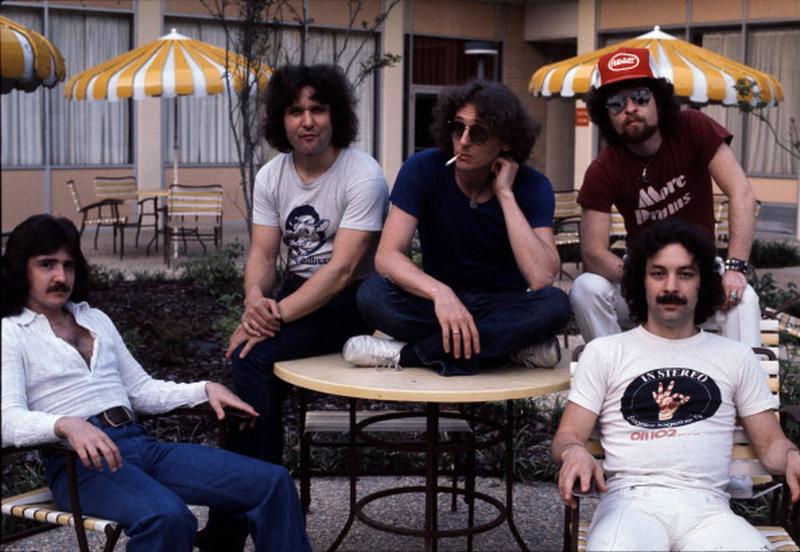The Unique Story Of “(Don’t Fear) The Reaper” By Blue Oyster Cult And More Cowbell
By | July 16, 2022

“(Don’t Fear) The Reaper '' by Blue Oyster Cult cheated its namesake by transcending into a pop culture legend, thanks to its genius and a cowbell. Written by Donald Roeser aka Buck Dharma in 1975, the massive hit also drastically altered the band itself. Blue Oyster Cult went from selling a few hundred thousand records to flirting with Billboard's top 10.
Rather than follow the usual course of fading into satisfying nostalgia, the song managed to outstrip its musical peak on the back of Will Ferrell relentlessly banging a cowbell 25 years later. Here’s the truly unique story of “(Don’t Fear) The Reaper.”

Jumping Cult
When “(Don’t Fear) The Reaper” hit, the boys of Blue Oyster Cult stretched the definition of “cult band.” As ex-drummer Albert Bouchard put it, “Suddenly there was some recognition for the band. And we had a lot more money. I bought a house, paid cash. I bought two cars. Three years later, the house is gone, the cars are gone. One was stolen, the other I lost in the divorce. It all came out to nothing [laughs].
Ironically, one band member stood steadfast against the hit-to-be before its release. Author Roeser remembered, “Eric Bloom didn’t think it was right for Blue Öyster Cult. The band was formed around Eric as the high-energy, menacing lead singer. He didn’t think it was the way the band should go.”
The Reaper's Inspiration
For a band famous for its fantastical lyrics, “(Don’t Fear) The Reaper” came from a profound and serious place. As Roeser told GQ, “I had an idea that I wanted to write a love story about transcending death. I was 22, and I had a heart arrhythmia, which developed in my late teens. I thought I might not live much longer. A cardiologist said, ‘It’s not something that’s gonna kill you.’ But dying had been on my mind.”
Of course, an artist can’t control the reception of their work and many took Roeser’s heartfelt lyrics as a clarion call for suicide. The guitarist dispelled such morbid notions,
“The second verse [“Romeo and Juliet/Are together in eternity”] is the one that causes so much trouble. I used Romeo and Juliet as an example of a couple who had faith to take their love somewhere else. They’re in eternity because they had the faith to believe in the possibility. It never occurred to me that people would think “Reaper” is an advertisement for suicide.”
A Cultural Touchstone Comeback
Roeser also drew on his relationship with his wife-to-be to create the all-timer. “So I thought of writing a song about, well, what if one of a couple dies? Is it possible to cross that divide of the mortal coil and reunite somehow? I was writing about characters, but insofar as it related to me personally, it was about me and Sandra. I was thinking about her when I wrote it.” Based on the litany of dramatic themes in the song, it’s hard to imagine how “(Don’t Fear) The Reaper” laid the foundation for one of the greatest SNL sketches ever.

Comedy Rebirth
SNL great Will Ferrell related where the idea came from. "Every time I heard [the song], I would hear the faint cowbell in the background and wonder, 'What is that guy's life like?'" Apparently, “that guy” was producer David Lucas, who felt the song "needed some momentum," grabbed what turned out to be an extremely consequential cowbell, and "just played four on the floor... not hard to do."
Clearly, the axiom of art imitating life holds some truth. Ferrell, Chris Kattan, Chris Parnell, and Christopher Walken parodied the hypothetical coming together of “(Don’t Fear) The Reaper” to a side stitching degree and over 20 million views on youtube.
SNL Magic
Chris Kattan retells the scene better than anyone:
“There was a magic element, regarding the chemistry with Will and the rest of the cast. Christopher Walken’s delivery is so separate from us. It feels like two worlds: Will and us, and then Christopher Walken, who always seems like he’s visiting from another planet when he does sketch comedy.
After the dress rehearsal, Will came up to me and said, “Hey Kattan, when you say your line ‘Don’t blow this for us, Gene,’ I want you to push me really hard.” I have some strength, even though I have the appearance of an ant. I pushed him hard enough to fall backwards, and that’s when his belly fell out of the shirt even further. Jimmy [Fallon] laughed, and that’s when the dominoes of character breaking happened. Walken never broke. He’s visiting from another planet, so he doesn’t understand.
I don’t even think I knew there was a cowbell in the sketch, to be honest. But that’s the beauty of it. It took something that really is not very much and blows it up to make it important.”
The band for their part found the spoof uproarious. "It's really funny," said Roeser. "The band had no idea it was coming, either. It was quite a surprise and phenomenal in its endurance and the way it's worked its way into the culture. If the cowbell has been at all an annoyance for Blue Öyster Cult, it's got to be 10 times worse for Christopher Walken! So, I'm riding that horse in the direction it's going."
